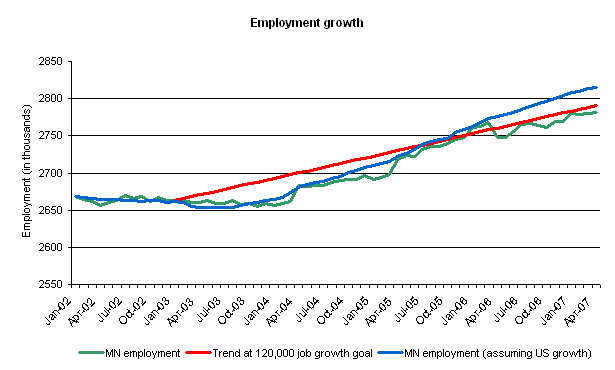| |
 |
DEPARTMENT
RESULTS |
|
| |
|
| |
|
|
|
Goal:
Create high-quality new jobs in Minnesota by promoting business creation,
expansion, and relocation |
| |
Why
is this goal important?
Jobs –
particularly high-quality jobs – drive Minnesota’s
 economy
by providing Minnesotans with wage income and creating the tax base to
preserve the
state’s high quality of life. The goal of DEED’s business development
efforts is the creation and retention of high-quality jobs for Minnesotans. This goal is at the heart of DEED’s overall mission of promoting economic
growth and the Governor’s goal of increasing jobs and economic
opportunities. economy
by providing Minnesotans with wage income and creating the tax base to
preserve the
state’s high quality of life. The goal of DEED’s business development
efforts is the creation and retention of high-quality jobs for Minnesotans. This goal is at the heart of DEED’s overall mission of promoting economic
growth and the Governor’s goal of increasing jobs and economic
opportunities.
A key strategy of
this goal is DEED’s work helping Minnesota businesses enter and expand
export markets. Businesses are learning that international customers are
their fastest-growing markets. One in six Minnesota manufacturing jobs is
export-related. On average, companies that export are more productive, offer
higher wages and more benefits, and experience greater job growth than
non-exporters.
|
| |
What
is DEED doing to achieve this goal?
 To
attract and maintain the state’s economic vitality, DEED focuses on three
aspects of business growth: creation, expansion, and relocation from other
states. To
attract and maintain the state’s economic vitality, DEED focuses on three
aspects of business growth: creation, expansion, and relocation from other
states.
DEED supports
business creation through the Small Business Assistance Office and the nine
Small Business Development Centers, which provide more than 40,000 hours of
one-on-one counseling to over 3,000 business clients each year. DEED also
works on ensuring a business-friendly climate for new and existing
businesses through initiatives such as a new partnership with the Pollution
Control Agency to streamline the environmental permitting process.
DEED’s business
development specialists support business expansion by connecting businesses
with DEED resources. DEED can provide assistance ranging from financial
support for business expansion through programs like the Minnesota
Investment Fund to matching financial support for job training through the
Minnesota Job Skills Partnership. Each year, DEED provides millions of
dollars in loans and grants to businesses and communities to support job
creation and retention.
|
 |
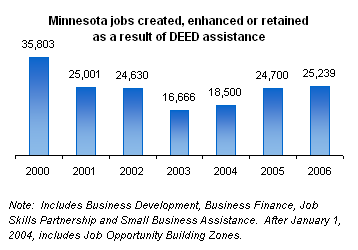 |
DEED
conducts a variety of marketing efforts to encourage businesses to locate or
relocate in Minnesota. DEED staff visit over 1,000 companies a year, both
responding to inquiries and making initial contacts. DEED’s “Positively
Minnesota” marketing campaign promotes the state as a place for business
expansion to existing and out-of-state companies. The Job Opportunity
Building Zones (JOBZs) are assisting DEED in promoting business expansion
and relocation by reducing the tax burden in select locations across the
state.
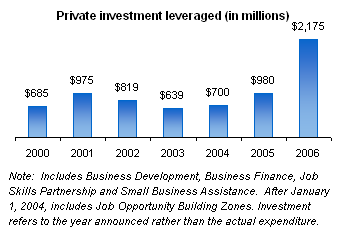
Community
development programs support all of these efforts by ensuring that
Minnesota’s communities – particularly in Greater Minnesota – have the
infrastructure to support business development. Specific community
development activities include grants and loans for brownfield cleanup,
redevelopment, and public facilities (such as sewer and water systems).
The Minnesota
Trade Office provides individualized export counseling and technical
assistance, export education programs, promotional events, and market
research resources to assist Minnesota businesses in successfully competing
in the global marketplace. While continuing to build on its strengths in
Minnesota’s top export markets and industries, DEED is placing new emphasis
on responding to emerging export opportunities, expanding export education
and outreach throughout the state, and building new alliances to enhance
service delivery. DEED will continue to organize trade missions and study
tours to facilitate more Minnesota businesses desiring to explore foreign
market opportunities. |
| |
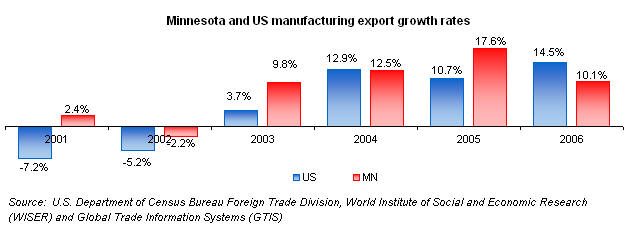 |
| |
How is DEED doing?
Compared to the
nation, the Minnesota economy is doing well, with the state unemployment
more than a full percentage point below the national rate (see the
current unemployment rate ). In
recent months, DEED has had a role in a number of high-profile Minnesota
business expansions, including Arctic Cat, Suzlon, Federal-Mogul, and
Menards distribution. Through July 2006, 254 businesses have agreed to
locate in JOBZs, create more than 3,800 jobs and invest nearly $300 million
in private investment. DEED initiatives are continuing to support business
creation, attraction, and expansion efforts in Minnesota; without DEED’s
efforts, many of these jobs are likely to have ended up elsewhere outside of
Minnesota.
For more
information on:
● JOBZ (http://www.deed.state.mn.us/bizdev/jobz.htm)
●
DEED (http://www.deed.state.mn.us)
●
Exports (http://www.exportminnesota.com/)
|
| |
|
|
|
Goal:
Strengthen Minnesota’s economy by connecting businesses and workers |
| |
Why
is this goal important?
In survey after
survey, businesses report that one of their top challenges is finding the
qualified workers they need. People with jobs can be economically
self-sufficient and independent of public assistance (such as welfare or
unemployment insurance). Reducing the duration of unemployment, i.e.,
accelerating how quickly unemployed persons find new jobs, also reduces the
unemployment insurance tax burden on businesses. Through over 40 Minnesota
WorkForce Centers across the state, DEED acts as a catalyst that connects
businesses with the job seekers they need.
|
| |
What
is DEED doing to achieve this goal?
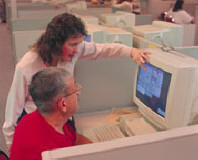
DEED provides a
variety of tools and services to help businesses better manage their labor
force. Through Minnesota’s Job Bank, businesses can post vacant positions
and search for qualified job candidates. DEED also provides businesses with
labor market information, human resource assistance, employment law
information, federal tax credits for hiring welfare recipients and persons
with disabilities, and Job Fairs to help with business hiring activities.
WorkForce Center
staff help job seekers prepare for, find, and retain employment by teaching
them job-seeking and job-retaining skills; conducting career interest and
skill assessments; helping individuals prepare resumes and improve their
interviewing skills; and providing career information, listings of available
jobs, individual counseling, and financial help for job training. WorkForce
Center Resource Areas provide job seekers with free access to computers,
software, the Internet, phones, fax, and printers to assist them in their
job search efforts. While many of DEED’s job seeker services are available
to anyone, DEED also provides targeted services to individuals receiving
welfare, veterans, and individuals that face physical and/or mental barriers
to employment.
|
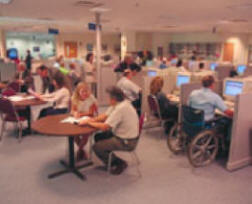 |
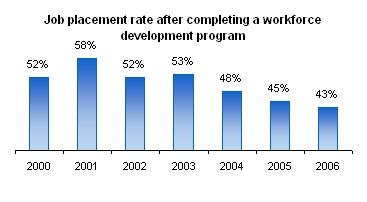
|
Several initiatives are
currently focused on improving services to both businesses and individuals,
including efforts to expand the workforce services available to businesses,
streamline the Dislocated Worker program, refine performance measures
driving service delivery, and better connect workforce development services
to regional economic development projects.
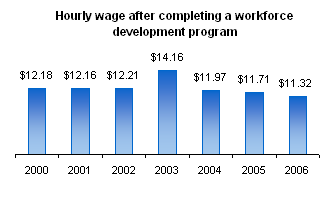 |
Note:
This indicator
reflects the success of the following publicly funded workforce development
programs – Dislocated Worker Program, Food Support Employment and Training,
Minnesota Family Investment Program Employment Services,
State Services for the Blind Workforce Development, Vocational
Rehabilitation, Welfare-to-Work, and Workforce Investment Act Title I-B
adult and dislocated worker programs. |
|
| |
How
is DEED doing?
The placement
rate, (job seekers who are employed after participating in a workforce
development program), indicates how effective DEED’s services are. Wage
levels indicate the quality of those jobs and their contribution to both
individual and economic well-being. These two measures help DEED assess the
overall success of workforce development services to individuals. In the
current economic environment, customers are finding fewer opportunities for
placement and less placement at higher wages. |
| |

|
| |
The
latest results from DEED’s WorkForce Center customer surveys reflect a high
degree of satisfaction among both businesses and job seekers with services
provided by Minnesota’s WorkForce Center System. Businesses served during
the 12-month period ending December 2006 reported an overall satisfaction
score of 75.4 (scores range from 0 to 100) on the American Customer
Satisfaction Index (ACSI). Jobseekers reported an average ACSI satisfaction
score of 71.6. To put these results into perspective, businesses using the
ACSI include FedEx (86), Target (77), Xcel Energy (70), Delta Airlines (64),
and Qwest Communications (70).
For more
information on:
● DEED http://www.deed.state.mn.us |
| |
|
| |
Goal:
Contribute to economic strength of Minnesota by providing superior
unemployment insurance service for individuals and employers
|
| |
Why
is this goal important? 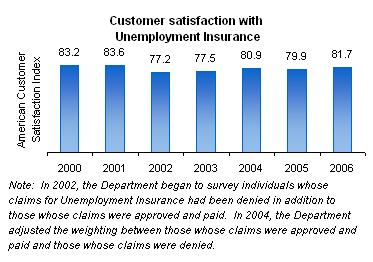
Unemployment
insurance (UI) is an important workforce and economic stabilizer. UI
benefits provide a temporary safety net that allows qualified individuals to
more easily transition to their next job. UI benefits also help employers
manage seasonal work and work fluctuations by ensuring a supply of skilled
labor that can return to work after a temporary layoff event. A superior UI
program must address these needs in an efficient and effective manner that
continually adapts to changing demands of our society.
Minnesota’s
Unemployment Insurance (UI) Program was enacted in 1936 with the primary
purpose of providing a temporary partial wage replacement to those Minnesota
workers who had become unemployed through no fault of their own. In 2006,
more than 175,000 Minnesotans received a total of over $680 million in
unemployment benefits from the state and federal Unemployment Insurance
Trust Funds.
|
| |
Significant UI activities include determining the amount of worker potential
benefits, resolving benefit disputes (determining whether employment loss
was caused by the applicant), and ensuring the accuracy of the benefit
payment process.
The UI
system is based on an insurance model with premiums paid by employers. The
premiums are experience-rated; those employers with a history of layoffs pay
a higher rate than those with no worker layoffs. The Department is
responsible for calculating rates for and collecting payments from over
125,000 employers, and determining if new employers are covered under the UI
program.
|
| |
What is DEED doing
to achieve this goal?
The UI Program has been dealing with
three challenges: 1) reduced administrative funding from the U.S. Department
of Labor, 2) aging technology, and 3) unpredictable workloads and increased
customer expectations. To address these challenges, DEED continues to
manage three major transitions: 1) changing from staff-operated manual
processes to automated processes; 2) moving from staff-managed operations to
customer controlled interactions; and 3) refocusing staff from supporting
internal processes to providing solutions for external customer service
needs.
|
| |
How is
DEED’s progress?
Previously
staff-intensive and paper-based, the new employer on-line system was
implemented in the summer of 2005. It is 100% self-service allowing
employers to file their quarterly wage detail reports, compute their UI
taxes due, and make their payments. UI taxes are now processed in
minutes, where formerly it took weeks. In 2006, 73% of employers paid their
UI taxes electronically, up from 27% in 2005. This translates to 88% of all
2006 UI tax dollars collected.
While Minnesota has taken applications for
UI benefits online at
www.uimn.org
since 1999, 2006 saw an increase in
usage, with 41% of applicants applying online, up from 35% in 2005. Nearly
all the remaining applications were done over the telephone using a
toll-free number. Going into an office and filling out a piece of paper is
a thing of the past.
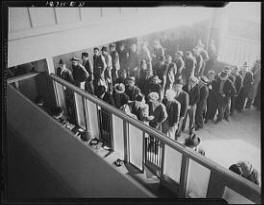 |
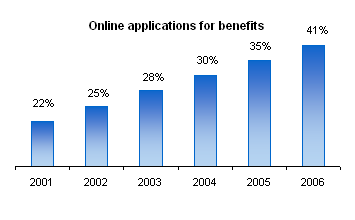 |
|
The way things used to be... |
Once an
application is filed, applicants are then required, on a bi-weekly basis, to
file a certification that they are unemployed and meet the ongoing
eligibility requirements, and to report any earnings. It is this continued
request that triggers a benefit payment. In 2006, 29% of the over 1.4
million continued requests were filed online. The vast majority of the rest
were done over the telephone, toll-free, through an interactive voice
response process. In contrast, during 2005, only 11% of continued requests
were filed online.
In early
August 2006, the program began making UI benefit payments using debit cards
instead of paper checks. In addition to the payments now made by debit
card, a substantial increase in direct deposits has occurred – from 16% of
all payments in April 2006 to over 58% in November 2006. This has
eliminated the problem of lost and stolen checks, benefiting both applicants
and program administration.
While most
applicants for unemployment benefits are laid off due to lack of work, about
35 percent become unemployed because they quit or are fired. Under limited
circumstances, individuals who quit are eligible for benefits, and those
fired are denied benefits only if misconduct was involved. A fact-gathering
process is required with an individual judgment made in each of over 60,000
cases. Additionally, 80,000 issues of ongoing eligibility must be
adjudicated. This critical process is time-consuming and labor-intensive,
involving a significant percentage of the entire UI staff.
In 2006, a
major initiative was implemented to improve the quality and timeliness of
this critical function. Appeals from initial adjudications were filed in
over 18,500 cases in 2006. Each appeal requires a hearing before an
unemployment law judge. Changes made in the handling of appeals have
allowed Minnesota to improve performance over the last four years, going
from the
bottom third of states to the top ten in the timely handling of appeals –
while maintaining a level of quality at nearly 98%. This means that
individuals who are determined eligible for benefits receive their payment
more quickly and those denied benefits
are notified sooner, reducing overpayments and the costs involved in
recouping those overpayments. nearly 98%. This means that
individuals who are determined eligible for benefits receive their payment
more quickly and those denied benefits
are notified sooner, reducing overpayments and the costs involved in
recouping those overpayments.
2007 is
scheduled to bring delivery on the second and final phase of a major
overhaul of the UI technology system that began in the fall of 2001. The
new benefits system, scheduled to be implemented on September 30, will make
the program much more streamlined for applicants. Everything about the
applicant’s UI account will be available to the applicant online, and
virtually all UI activities may be done online. All activities will be
processed faster and benefit payments made more quickly. The new system
will result in a significant reduction in erroneous payments, which will
help the trust fund balances and ultimately result in lower taxes on
employers. The system design incorporates a number of changes to benefit
payments that requires legislative action during the 2007 session. These
changes include an expansion of coverage to new labor market entrants,
meaning that more than 2,000 individuals who are now denied will be eligible
for benefits.
For more
information, visit:
www.uimn.org |
| |
Last update on
07/23/2007
|



